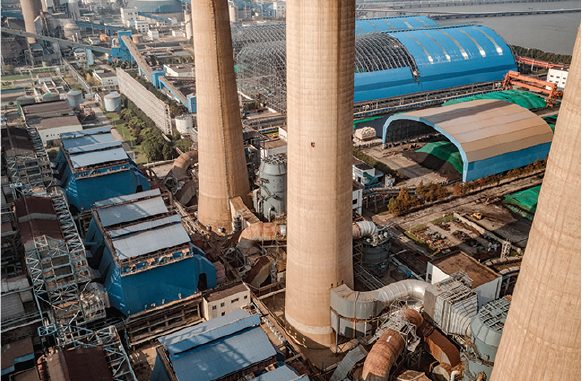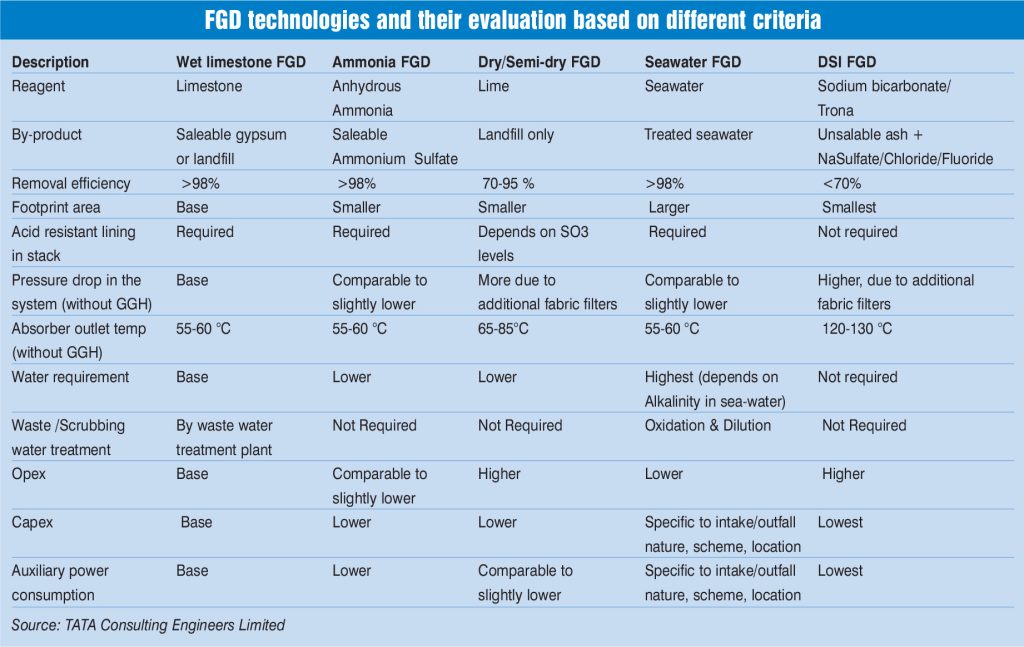
For coal-fired power plants, several technology solutions are available to meet the SOX emission standards prescribed by the Ministry of Environment, Forest and Climate Change. Wet FGD based on limestone is one of the most commonly used methods for SOX control. The process of FGD is designed to absorb the sulphur dioxide (SO2) in the flue gas before it is released. This can be achieved through many reagents and sorbents.
FGD installation progress
FGD systems have been planned for 600 units aggregating 211.52 GW in capacity. As per the CEA’s report, as of March 2023, FGD systems are operational in 22 units aggregating 9,280 MW. The state sector plants have planned FGD installation for 222 units aggregating 68,266.5 MW while the central sector plants have planned installations for 168 units totalling 67,250 MW. Sector-wise, bids have been awarded for 135 units in the central sector, 46 units in the private sector and 38 units in the state sector, representing 80 per cent, 17 per cent and 22 per cent of the total planned capacity, respectively. A total of 219 bids aggregating 100,430 MW have been awarded, which account for 47.5 per cent of the total planned capacity.
Technologies
Dry FGD: This involves dry scrubbing injection systems using lime as a reagent to react and remove gaseous waste. Dry methods are of two types — dry sorbent injection systems and spray drying systems. Both the processes inject lime into flue gas to remove SO2. In the dry injection process, dry hydrated lime is injected directly into the flue gas duct. The spray dry system injects atomized lime slurry into a separate vessel. Dry sorbent injection (DSI) is another dry FGD technology, suitable for small-sized units ranging between 60 MW and 250 MW. NTPC is implementing FGD through DSI technology in its older and small units. DSI system erection work is at advanced stages in two units of Tanda Stage I (4×110 MW).
Semi-dry FGD: Semi-dry FGD uses slaked lime or quick lime as a sorbent that is blown into the boiler furnace above the flame area, to remove SO2 from flue gas. The semi-dry process achieves better FGD efficiency as compared to the dry process and sulphites are retained as a by-product.
Wet FGD: Wet limestone-based FGD is the most versatile and prominent technology for SOX removal that is being adopted by the majority of the TPPs in the country. The wet FGD process involves wet scrubbing using an alkaline slurry of lime to scrub gases. Lime slurry is then sprayed into a flue gas scrubber. Then the SO2 is absorbed into the spray to transform into wet calcium sulphite. The by-product of the process is sulphite, which is usually converted into saleable gypsum.
Ammonia-based FGD: In a wet FGD process when ammonia is used as the sorbent, it is referred to as ammonia-based FGD. In this process, ammonia water is used to extract SO2 from industrial waste gas. It generates ammonium sulphate as a by-product.
Seawater FGD: This process is particularly useful for plants located in coastal areas as it employs sea water as a reagent. It clears up more than 95 per cent of the pollutants with no by-products. The effluents from the process are treated in the dilution and aeration basin to boost the DO level and pH, thus leaving no by-products. A sea water-based FGD system was installed at the Mundra thermal power station which is located on the coastline of Gujarat, for five of its 800 MW units. The technology for the plant has been selected on the basis of the sea water flow rate in the absorber compared to the flue gas flow rate, gas ratios and velocities, making it a success story for others to follow.

Technology selection
There are various technologies available for SOX removal. The selection of a suitable SOX control technology is essential to achieve the desired results and objectives. Some of the key factors to consider while selecting technology are:
Fuel quality: must take into account the quality of coal available, as it determines the types of pollutants they need to deal with. The utility must select an FGD technology that can effectively minimise emissions based on the available coal.
Availability of reagents and quality of reagents: FGD technologies are reagent-dependent and their availability and quality has the ability to affect and even compromise the whole process. Therefore, it is a crucial factor in selecting the suitable FGD technology.
Required SOX abatement efficiency: The utility needs to select a technology that can assist in achieving the required levels of outlet emissions, as per the Ministry of Environment, Forests and Climate Change, and prioritise technologies that support this goal.
Space availability for FGD retrofits: FGD retrofits take up large amounts of space with their complex equipment. Therefore, it is imperative to ensure space optimisation of a plant without compromising on its output so that FGD retrofits are easily built into the original framework of the plant.
Water availability: Water availability is a critical factor in selecting between technologies. The amount and type of water available play a significant role. In areas such as Rajasthan or remote regions where water is scarce, dry FGD is preferable and can be combined with technologies such as cooling towers to optimise water usage. For plants located near coastal areas, seawater FGD can be selected. Water availability determines the FGD technology and the necessary supplemental technologies required to reduce emissions.
Disposal of by-products: If a certain technology generates by-products that are difficult to dispose of due to factors such as plant location, costs, existing plant equipment systems or simply being hazardous, it is prudent to opt for another technology.
Capex, opex and life cycle cost estimation: While adopting FGD technology, it is important to consider the lifecycle of the equipment and the expenses of the plant in order remain financially stable while going green. The selection of an optimal technology based on technical and economic viability will improve plant performance in the long run. Balance plant life, life cycle costing and plant load factor are other factors that help determine a suitable technology.
Limestone-based FGD technologies have several advantages such as low-cost reagents, marketable by-products and ease of retrofitting, but they also have disadvantages such as high capital cost and auxiliary power consumption (APC), and difficult waste disposal.
Dry FGD requires low capital cost, moderate APC and generates a useful dry by-product that is easy to manage, operate and maintain. However, the cost of reagents is high and lime is difficult to source and handle. Meanwhile, DSI FGD is expensive due to the high cost of reagents, making it preferable only for units running on low PLF and with a shorter balance operating life of seven to nine years.
Ammonia-based FGD also has a low capital cost and APC consumption, and generates a marketable by-product while absorbing 99 per cent of effluents. The downside is the high cost of reagents and hazardous by-products, which require permission to store and sell.
Seawater-based FGD involves low capital cost, low APC, needs no reagent, and generates no by-product while clearing up all effluent discharge, making it the best option for coastal plants. However, it is not viable for other plants.
Overall, the progress of FGD installation in the country has been slow up till now. However, with the adoption of the right FGD technology and constant efforts to reduce emissions, TPPs will meet the emission standards soon.
